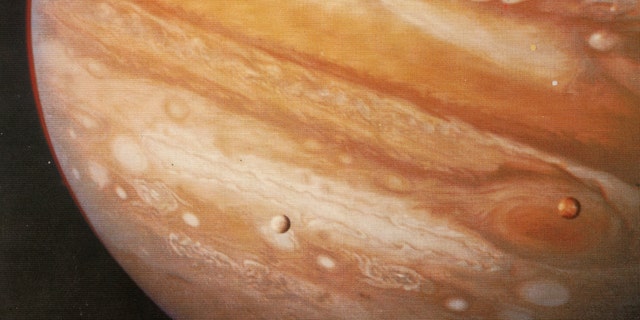A green comet discovered last March will make its closest approach to Earth this month.
The comet C/2022 E3 (ZTF) was first discovered by astronomers using the wide-field survey camera at California’s Zwicky Transient Facility.
It was already inside the orbiter of Jupiter.
Since then, it has brightened substantially and is sweeping across the northern constellation Corona Borealis in predawn skies, according to NASA.
QUADRANTID METEOR SHOWER PEAKS AS MOON CREATES POOR VIEWING CONDITIONS

The planet Jupiter, 1979. Taken from Voyager 1 at 20 million kilometres this pictures shows the Great Red Spot, a storm that has been raging for hundreds of years, and two of Jupiter’s moons – Io over the Red Spot and Europa.
((Photo by Oxford Science Archive/Print Collector/Getty Images))
The agency notes that it is still too dim to see without a telescope – though an image from December reveals its bright coma, short broad dust tail and faint ion tail.
The comet will be at perihelion, its closest to the sun, on Jan. 12 and at the closest to Earth on Feb. 1.
WALTER CUNNINGHAM, LAST SURVIVING NASA APOLLO 7 ASTRONAUT, DIES AT 90: ‘TRUE HERO’

Comet NEOWISE (C/2020 F3) on July 27, 2020, from the Columbia Icefields (Jasper National Park, Alberta) from the Toe of the Glacier parking lot, looking north over Sunwapta Lake, formed by the summer meltwater of Athabasca Glacier.
((Photo by: Alan Dyer/VW PICS/Universal Images Group via Getty)
NASA notes that the brightness of comets is unpredictable, but that – by then – C/2022 E3 (ZTF) could become only just visible to the eye in night skies.
“Observers in the Northern Hemisphere will find the comet in the morning sky, as it moves swiftly toward the northwest during January. (It’ll become visible in the Southern Hemisphere in early February),” it said.
This comet isn’t expected to be quite as much of a spectacle as Comet NEOWISE was in 2020.

A Neanderthal man at the human evolution exhibit at the Natural History Museum in London, England, United Kingdom.
((photo by Mike Kemp/In Pictures via Getty Images Images))
CLICK HERE TO GET THE FOX NEWS APP
It has a full orbit of around 50,000 years, according to NASA’s Jet Propulsion Laboratory, meaning that the last time it came so close to Earth was when Neanderthals roamed the planet.
